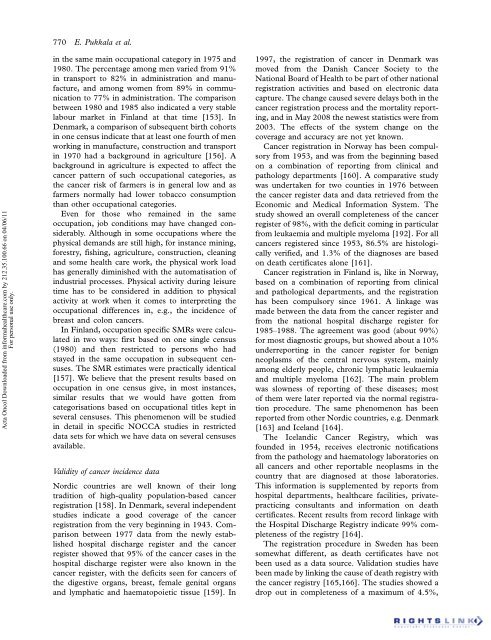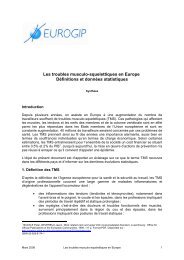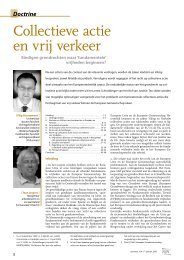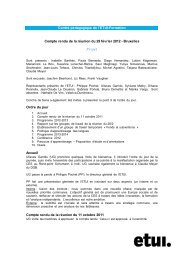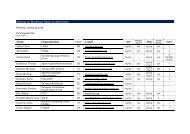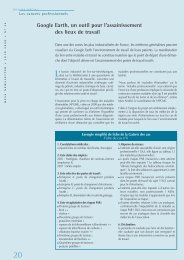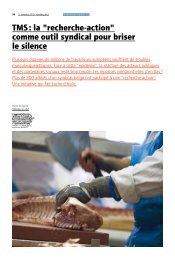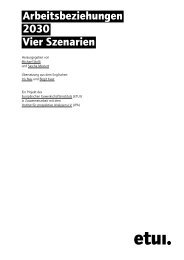Occupation and cancer - European Trade Union Institute (ETUI)
Occupation and cancer - European Trade Union Institute (ETUI)
Occupation and cancer - European Trade Union Institute (ETUI)
Create successful ePaper yourself
Turn your PDF publications into a flip-book with our unique Google optimized e-Paper software.
Acta Oncol Downloaded from informahealthcare.com by 212.35.100.66 on 04/06/11<br />
For personal use only.<br />
770 E. Pukkala et al.<br />
in the same main occupational category in 1975 <strong>and</strong><br />
1980. The percentage among men varied from 91%<br />
in transport to 82% in administration <strong>and</strong> manufacture,<br />
<strong>and</strong> among women from 89% in communication<br />
to 77% in administration. The comparison<br />
between 1980 <strong>and</strong> 1985 also indicated a very stable<br />
labour market in Finl<strong>and</strong> at that time [153]. In<br />
Denmark, a comparison of subsequent birth cohorts<br />
in one census indicate that at least one fourth of men<br />
working in manufacture, construction <strong>and</strong> transport<br />
in 1970 had a background in agriculture [156]. A<br />
background in agriculture is expected to affect the<br />
<strong>cancer</strong> pattern of such occupational categories, as<br />
the <strong>cancer</strong> risk of farmers is in general low <strong>and</strong> as<br />
farmers normally had lower tobacco consumption<br />
than other occupational categories.<br />
Even for those who remained in the same<br />
occupation, job conditions may have changed considerably.<br />
Although in some occupations where the<br />
physical dem<strong>and</strong>s are still high, for instance mining,<br />
forestry, fishing, agriculture, construction, cleaning<br />
<strong>and</strong> some health care work, the physical work load<br />
has generally diminished with the automatisation of<br />
industrial processes. Physical activity during leisure<br />
time has to be considered in addition to physical<br />
activity at work when it comes to interpreting the<br />
occupational differences in, e.g., the incidence of<br />
breast <strong>and</strong> colon <strong>cancer</strong>s.<br />
In Finl<strong>and</strong>, occupation specific SMRs were calculated<br />
in two ways: first based on one single census<br />
(1980) <strong>and</strong> then restricted to persons who had<br />
stayed in the same occupation in subsequent censuses.<br />
The SMR estimates were practically identical<br />
[157]. We believe that the present results based on<br />
occupation in one census give, in most instances,<br />
similar results that we would have gotten from<br />
categorisations based on occupational titles kept in<br />
several censuses. This phenomenon will be studied<br />
in detail in specific NOCCA studies in restricted<br />
data sets for which we have data on several censuses<br />
available.<br />
Validity of <strong>cancer</strong> incidence data<br />
Nordic countries are well known of their long<br />
tradition of high-quality population-based <strong>cancer</strong><br />
registration [158]. In Denmark, several independent<br />
studies indicate a good coverage of the <strong>cancer</strong><br />
registration from the very beginning in 1943. Comparison<br />
between 1977 data from the newly established<br />
hospital discharge register <strong>and</strong> the <strong>cancer</strong><br />
register showed that 95% of the <strong>cancer</strong> cases in the<br />
hospital discharge register were also known in the<br />
<strong>cancer</strong> register, with the deficits seen for <strong>cancer</strong>s of<br />
the digestive organs, breast, female genital organs<br />
<strong>and</strong> lymphatic <strong>and</strong> haematopoietic tissue [159]. In<br />
1997, the registration of <strong>cancer</strong> in Denmark was<br />
moved from the Danish Cancer Society to the<br />
National Board of Health to be part of other national<br />
registration activities <strong>and</strong> based on electronic data<br />
capture. The change caused severe delays both in the<br />
<strong>cancer</strong> registration process <strong>and</strong> the mortality reporting,<br />
<strong>and</strong> in May 2008 the newest statistics were from<br />
2003. The effects of the system change on the<br />
coverage <strong>and</strong> accuracy are not yet known.<br />
Cancer registration in Norway has been compulsory<br />
from 1953, <strong>and</strong> was from the beginning based<br />
on a combination of reporting from clinical <strong>and</strong><br />
pathology departments [160]. A comparative study<br />
was undertaken for two counties in 1976 between<br />
the <strong>cancer</strong> register data <strong>and</strong> data retrieved from the<br />
Economic <strong>and</strong> Medical Information System. The<br />
study showed an overall completeness of the <strong>cancer</strong><br />
register of 98%, with the deficit coming in particular<br />
from leukaemia <strong>and</strong> multiple myeloma [192]. For all<br />
<strong>cancer</strong>s registered since 1953, 86.5% are histologically<br />
verified, <strong>and</strong> 1.3% of the diagnoses are based<br />
on death certificates alone [161].<br />
Cancer registration in Finl<strong>and</strong> is, like in Norway,<br />
based on a combination of reporting from clinical<br />
<strong>and</strong> pathological departments, <strong>and</strong> the registration<br />
has been compulsory since 1961. A linkage was<br />
made between the data from the <strong>cancer</strong> register <strong>and</strong><br />
from the national hospital discharge register for<br />
1985 1988. The agreement was good (about 99%)<br />
for most diagnostic groups, but showed about a 10%<br />
underreporting in the <strong>cancer</strong> register for benign<br />
neoplasms of the central nervous system, mainly<br />
among elderly people, chronic lymphatic leukaemia<br />
<strong>and</strong> multiple myeloma [162]. The main problem<br />
was slowness of reporting of these diseases; most<br />
of them were later reported via the normal registration<br />
procedure. The same phenomenon has been<br />
reported from other Nordic countries, e.g. Denmark<br />
[163] <strong>and</strong> Icel<strong>and</strong> [164].<br />
The Icel<strong>and</strong>ic Cancer Registry, which was<br />
founded in 1954, receives electronic notifications<br />
from the pathology <strong>and</strong> haematology laboratories on<br />
all <strong>cancer</strong>s <strong>and</strong> other reportable neoplasms in the<br />
country that are diagnosed at those laboratories.<br />
This information is supplemented by reports from<br />
hospital departments, healthcare facilities, privatepracticing<br />
consultants <strong>and</strong> information on death<br />
certificates. Recent results from record linkage with<br />
the Hospital Discharge Registry indicate 99% completeness<br />
of the registry [164].<br />
The registration procedure in Sweden has been<br />
somewhat different, as death certificates have not<br />
been used as a data source. Validation studies have<br />
been made by linking the cause of death registry with<br />
the <strong>cancer</strong> registry [165,166]. The studies showed a<br />
drop out in completeness of a maximum of 4.5%,


